ISSN 2286-4822 www.euacademic.org
Impact Factor: 3.4546 (UIF) DRJI Value: 5.9 (B+)
Assessment of Natural Radioactivity Concentration
and Dose in Surface Soil Samples from Atbara
HASHIM GAD ELSEED MOHAMMED HASHIM ALBASHIR Department of Physics Faculty of Education, Nile Valley University
Sudan
Abstract:
Gamma-ray spectroscopy system using NaI (Tl) "1.5×2"
detector in low-background with 24 hour. has been used to determine the soil radioactivity concentrations of Th-232, U-238 and K-40 in 11 soil samples collected from Atbara. The radioactivity concentration
ranged from 29.34to 20.34 Bq.kg-1 for U-238 ; from 20.92to 7.17±0.22
Bq/kg-1 for Th-232; from 220.50to 176.51Bq.kg-1 for K-40 . The
calculated absorbed dose rate values are between 22.9±1.80 to
32.4±1.70 nGy.h-1. its under to the world average value (60 nGy/h).
The annual effective doses range from 28.10±2.20 to 42.33±2.29 μSv.y−1
The annual effective doses and the external hazard index (Hex) values
from sample less than the average worldwide limits.
Key words: Gamma-ray, Annual effective doses, External hazard index, soil, Atbara
1- INTRODUCTION
evaluate the terrestrial gamma dose rate for outdoor occupation, it is very important to estimate the natural radioactivity level in soils [1]
.
Estimation of the radiation dose distribution is important in assessing the health risk to a population and serve as the reference in documenting changes to environmental radioactivity in soil due to anthropogenic activities[2]. Natural environmental radioactivity depends on the geological and geographic conditions, and appears at different levels in the soils of each different geological region[3]. Human beings have always been exposed to natural radiations arising from within and outside the earth. The exposure to ionizing radiations from natural sources occurs because of the naturally occurring radioactive elements in the soil and rocks, cosmic rays entering the earth’s atmosphere from outer space and the internal exposure from radioactive elements through food, water and air[4].
Only natural radionuclides with half lives comparable with the age of the Earth or their corresponding decay products existing in terrestrial material such as 232Th, 238U and40K, and K40 are of great interest. The levels of these radionuclides are relatively distributed in soil based on the nature of its geological formations[5]. As radioisotopes spread in the whole ecosystem of the Earth they do not produce an essential problem for the human beings. Meanwhile, some isotopes that enter the food chain may achieve concentrations that may be toxic for plant or animal organisms or their consumers. Because a higher concentration of radioactive substances in the environment is undesirable[6].
radionuclide activity concentrations in surface soil, outdoor gamma absorbed doses and the external hazard index (Hex).
2- METHOD
Atbara is a city of 17°43′N 33°59′E located in River Nile State in northeastern Sudan. It is located at the junction of the Nile and Atbara rivers. It is an important railway junction and railroad manufacturing centre, and most employment in Atbara is related to the rail lines. It is known as the "Railway City,' and The Sudanese National Railway Company's headquarters are located in Atbara
.
Each soil sample was collected from nine subsamples each location of about 120 m2 and were taken from the surface layer soil of10 cm to 15 cm depth. The soil samples were cleaned and sieved by a 0.8mm mesh to remove larger objects and then ground using a mortar and pestle to fine powder in order to have the same matrix as the reference sample. Sample was dried at room temperature for a few days and then in an oven at 100 ◦ C for about 3 days. In order to maintain radioactive equilibrium between between Rn222 and its parent Ra226 in uranium chain and its daughters the soil samples were sealed in 500-mL Marinelli beakers and then weighed and stored for 1 month.The samples were measured using gamma-ray spectroscopy system using NaI(Tl) "1.5×2" detector in low-background with 24 hour. The absorbed dose rates (D) are calculated according to UNSCEAR (2000) due to gamma radiation in air, 1m above the ground level for 232Th, 238U and40K radio nuclides as follows:
D (nGy.h−1)=(0.604 ATh+0.462 AU+0.0417AK) (1)
soil in Bq.Kg−1.The Effective dose rate(ED) (μSv.y−1) due to natural activity in the soil was calculated by: [7-8]
ED(μSv.y−1) = D ×24(h)×365.25(d)×rate (2)
the committee used 0.7 Sv.Gy−1 as the conversion coefficient from absorbed dose in air to effective dose received by adults, and 0.2 for the outdoor occupancy factor.
A hazard index called the external hazard index Hex is defined as follows (UNSCEAR, 2000):
Hex=AU/370+ATh/259+AK/4810≤1 (3)
3- RESULTS
The natural radioactivity of soil depends on the soil formation and transport processes that were involved since soil formation; chemical and biochemical interaction influence the distribution [9].the principal primordial radionuclides are 232Th, 238U and40K. Both 232Th and 238U head series of radionuclides that produce significant human exposures. The decay of naturally occurring radionuclides in soil produces a gamma-beta radiation field in soil that also crosses the soil-air interface to produce exposures to humans(5) The radioactivity concentration of 238U, 232Th, and 40K in the soil samples collected from different parts of the studied area are given in Table.1.
The radioactivity concentration ranged from 29.34to 20.34 Bq.kg-1 for U-238 show as Fig1 ; from 20.92to 7.17±0.22 Bq/kg-1 for Th-232 show as Fig2 ; from 220.50to 176.51Bq.kg-1 for K-40 show as Fig3 . The reported world median radioactivity levels for U- 238, Th -232, K- 40 are 35, 30, and 400 Bq kg-1, respectively.
radiation reported in Table2. The calculated absorbed dose rate values are between 22.9±1.80 to 32.4±1.70 nGy.h-1. It corresponds to the world average value (60 nGy/h). The corresponding outdoor annual effective doses range from 28.10±2.20 to 42.33±2.29 μSv.y−1 for Atbara, while the worldwide average annual effective dose is approximately 0.5 mSv.y−1 Thus, our results are one order magnitude less (0.05 mSv.y−1) than the average worldwide limits as reported by UNSCEAR.
Comparison of the calculated external hazard index from the measured samples with the corresponding world accepted upper limit (Hex = 1) are calculated in Table 2. the external hazard index values from sample are under the corresponding UNSCEAR upper limits.
Table 1. Concentration of (U-238, Th-232, and K-40) BqK-1 in Atbara soil samples
Sample code Location K-40 Th-232 U-238
S1 Alshargi 201.10±18.02 18.92±0.65 25.34±1.90
S2 Alshamali 220.50±17.90 15.92±0.40 25.14±1.41
S3 khiliwa 196.51±20.94 8.77±0.42 27.05±1.95
S4 Almatar 186.42±18.98 8.19±0.32 22.65±1.98
S5 Ombacol 199.70±17.40 20.92±0.55 29.34±1.75
S6 Almawrada 116.10±18.02 19.92±0.65 24.34±1.88
S7 Alrayan 185.81±17.91 7.75±0.75 24.22±1.41
S8 Alhasaia 176.51±18.94 7.17±0.22 27.05±1.91
S9 Alsawdan 197.45±21.90 15.49±0.39 21.85±1.94
S10 Aldakhla 184.70±19.40 10.02±0.75 20.34±1.73
S11 Alsiala 200.70±21.09 19.02±0.44 27.01±1.21
Max 220.50±17.90 20.92±0.55 29.34±1.75
Min 176.51±18.94 7.17±0.22 20.34±1.73
Mean 187.7±19.13 13.86±0.50 24.9±1.73
Table 2. Absorbed dose rate A.dose(nGy.h−1) , Annual effective dose AED (μSv.y−1) and External hazard index for Atbara
S.C A.dose A.E.D E.H.I
S6 28.1±2.01 34.48±2.46 0.17±0.01 S7 23.6±2.05 28.96±2.51 0.14±0.01 S8 22.9±1.80 28.10±2.20 0.14±0.01 S9 27.7±1.21 33.99±1.41 0.16±0.01 S10 23.2±2.05 28.47±2.51 0.13±0.01 S11 32.4±1.70 39.7±2.08 0.19±0.01 .
Fig. 1. Activity concentration U-238 for Atbara
Fig. 2. Activity concentration for Th-232 for Atbara
Fig. 3. Activity concentration K-40 for Atbara
S1 S2 S3 S4 S5 S6 S7 S8 S9 S10 S11
0 5 10 15 20 25 30 U -2 3 8 co n ce n tra ti o n (Bq /kg ) Samplig locations D
S1 S2 S3 S4 S5 S6 S7 S8 S9 S10 S11
0 5 10 15 20 T h -2 3 2 co n ce n tra ti o n (Bq /kg ) Samplig locations C
4- CONCLUSION
The aim of this study is the estimation of the concentration of radioactive elements Normal, U238, Th232, K40 and their progenies in the surface soil in the selected from Atbara. The radioactive concentration was measured using NaI(Tl) with low background. All the gama parameters were calculated and found to be consistence with the World average values.
REFERENCES
1. Rohit Mehra, Manmohan Singh, measurement of Radioactivity of U238, Ra226, Th 232andK40 in Soil of Different Geological Origins in Northern India, Journal of Environmental Protection, 2011, 2, 960-966
2. Ibrahim Hindawy, Radioactivity of 238U, 232Th, 40K, and 137Cs and assessment of depleted uranium in soil of the Musandam Peninsula, Sultanate of Oman, Turkish J. Eng. Env. Sci. 36 (2012) , 236 – 248.
3. B. Senthilkumar, V. Dhavamani, S. Ramkumar, and P. Philominathan, Measurement of gamma radiation levels in soil samples from Thanjavur using γ-ray spectrometry and estimation of population exposure, J Med Phys. 2010 Jan-Mar; 35(1): 48–53.
4. Obed RI, Farai IP, Jibiri NN. Population dose distribution due to soil radioactivity concentration levels in 18 cities across Nigeria. J Radiol Prot. 2005; 25:305– 12.
5. Orabi, H., Al-Shareaif, A. and El Galefi, M., “Gamma-ray Measurements of Naturally Occurring Radioactive Sample from Alkharje City”, Journal of Radioanalytical Nuclear Chemistry, 269, 99-102, 2006.
of building materials (Directorate-General Environment, Nuclear safety and civil protection) Radiat. Prot. 112 1-16.
7. UNSCEAR 2000 Sources and Effects of Ionizing Radiation: Report to the General Assembly, with scientific annexes vol 1 (United Nations, New York) 1- 654
8. UNSCEAR 2010 Sources and Effects of Ionizing Radiation: Report to the General Assembly, with scientific annexes vol 1 (United Nations, New York)1-219

